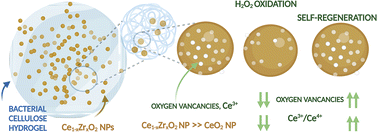
Hot off the press: New Paper in RSC: Nanoscale!
The article “Ce1−xZrxO2 nanoparticles in bacterial cellulose, bio-based composites with self-regenerating antioxidant capabilities” was published in The Royal Society of Chemistry: Nanoscale!
Former NN group member Johanna van Gent published this paper under the supervision of Anna Roig. The article is the result of her star with us at the ICMAB in 2022 and it shows the synthesis of CeO2 nanoparticles in bacterial cellulose (BC) enabling the formation of BC–CeO2 composites that exhibit self-regenerating antioxidant properties.
Abstract:
Bacterial cellulose (BC) is an emerging biopolymer with ever-widening uses in the biomedical field due to its purity, mechanical stability, conformability, moisture control, and biocompatibility. In the wet form, its highly porous nanofibrillar structure and abundant surface hydroxyl groups enable the functionalisation of BC with inorganic nanoparticles (NPs), granting the material additional purposive capabilities. As oxidative stress caused by reactive oxygen species (ROS) negatively affects various cellular structures, the functionalisation of BC with CeO2 NPs, known antioxidants, is pursued in this work to achieve composites capable of minimising inflammation and tissue damage. We report on low-temperature in situ syntheses of CeO2 NPs in BC enabling the formation of BC–CeO2 composites that exhibit self-regenerating antioxidant properties, as verified by 2,2-diphenyl-1-picrylhydrazyl (DPPH) assays and studies of the evolution in the CeO2 absorption edge (indicative of the Ce3+ and Ce4+ fractions). X-Ray photoelectron spectroscopy (XPS) further reveals that incorporation of zirconium into the CeO2 lattice leads to a four-fold increase in the Ce3+: Ce4+ ratio, thereby enhancing the composite antioxidant performance as exemplified by BC–Ce0.6Zr0.4O2 recording the highest %DPPH scavenging per unit mass of NPs among the BC–Ce1−xZrxO2 studied systems.
Anna Roig, bacterial cellulose, bc, CeO2 nanoparticles, johanna

